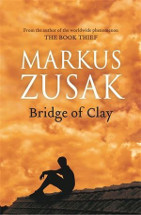Bridge of Clay by Markus Zusak

Pan Macmillan, 2018. ISBN 9781760559922
(Age: Adolescent - Adult) Recommended. With a story that is based on
the deep and abiding love of a family, this book plunges us deeply
into the world of the Carey family in a Melbourne suburb near one of
the great horse racing tracks. The five sons are educated at the
local school, but their home education is deeply embedded in the
Greek classics, with even their pets being named after the great
Greek heroic figures. This is a story that packs an enormous punch,
just as the boys do so often in their home, even though they are
surrounded by love and care. The book is suitable for older
adolescents, and certainly is a great read for adults.
Zusak has chosen a storyline that takes the reader through the years
of the boys youth, through the loss of their mother to illness,
their father's occasional abandonment, their loving care of their
somewhat unusual pets, and the animals that are ever-present in
their lives, especially the mule. All the names of the animals
represent the qualities that the boys attribute to their furry
friends, and this is the key to their shared set of values and
beliefs that holds them together when their mother dies and their
father appears to abandon them.
Choosing to weave his story deep in the suburbs of Melbourne, Zusak
takes us back and forth in time so that we have to construct the
storyline as we work to place each chapter in its right time. When
their father leaves them, after his wife's death, the boys fight and
play, read and build, but never stop supporting each other and find
ways to cope, in their inimitable style. The father is not a bad
figure but is grieving so deeply that he cannot stay with his sons.
Yet they forgive him!
Place matters in this text, and the story is set in different places
that re-appear throughout the narrative. We get to know The
surrounds, the bridge over the deep valley that they work to
construct, the racetrack and the racing horses, and the animals'
shelters at home. Clay's bridge, the shelters for the animals, their
home, the race track and local area are all deeply reflective of
this family. The mixing-up of the timeline appears to be reflective
of the more important issue of the deep and abiding love they share,
and of their memory of a loving mother who educated them in the best
of the ancient Greek values, of loyalty, goodness, and generosity,
all in the face of almost constant threats of disaster. This is a
long story, and is one that needs concentration to build its place
in time, and yet it is utterly captivating. It is hard to put down,
to let the boys go when the end comes, but we leave them with a deep
feeling of gratitude that although we have spent so much time with
them, we are sad that the narrative has ended. It is hard to believe
that this is not a true story, and it is likely that we might well
posit its essential truths as pertinent to our being human, and be
all the better as people for having read this wonderful novel.
Bridge of Clay is suitable for adolescent and adult reading.
Elizabeth Bondar